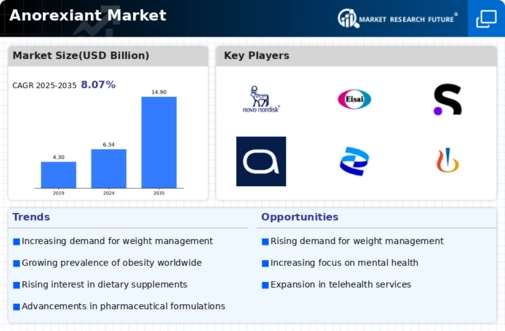Rising Obesity Rates
The increasing prevalence of obesity globally is a primary driver of the Global Anorexiant Market Industry. As obesity rates continue to rise, the demand for anorexiants, which assist in weight management, is expected to grow. According to recent statistics, the global obesity rate has reached alarming levels, prompting healthcare providers to seek effective solutions. This trend is likely to contribute to the market's projected growth, with the Global Anorexiant Market estimated to reach 6.34 USD Billion in 2024. The focus on combating obesity through pharmacological interventions underscores the significance of anorexiants in public health strategies.
Market Growth Projections
The Global Anorexiant Market Industry is poised for substantial growth, with projections indicating a market value of 6.34 USD Billion in 2024 and an anticipated rise to 14.9 USD Billion by 2035. This growth trajectory reflects a compound annual growth rate of 8.07% from 2025 to 2035. The increasing prevalence of obesity, advancements in drug development, and heightened awareness of weight management are key factors driving this expansion. As the market evolves, it is expected to attract significant investment and innovation, further enhancing the availability and effectiveness of anorexiants for consumers worldwide.
Growing Geriatric Population
The aging population worldwide is contributing to the expansion of the Global Anorexiant Market Industry. Older adults often face challenges related to weight management due to metabolic changes and comorbidities. As the geriatric population continues to grow, there is an increasing demand for effective anorexiants tailored to this demographic. The need for weight management solutions among older adults is likely to drive market growth, as healthcare providers seek to address obesity-related health issues in this population. This trend aligns with the overall market growth projections, indicating a robust future for anorexiants in addressing the unique needs of the elderly.
Advancements in Drug Development
Innovations in drug development are propelling the Global Anorexiant Market Industry forward. Recent advancements in pharmacology have led to the creation of more effective and safer anorexiants, which are gaining approval from regulatory bodies. These new drugs are designed to target specific pathways involved in appetite regulation, thereby enhancing efficacy. The introduction of novel formulations and delivery mechanisms is likely to attract a broader patient demographic. As a result, the market is poised for substantial growth, with projections indicating a rise to 14.9 USD Billion by 2035, reflecting the ongoing commitment to improving obesity treatment options.
Regulatory Support for Anorexiants
Regulatory bodies are increasingly supportive of the development and approval of anorexiants, which is a crucial factor for the Global Anorexiant Market Industry. Streamlined approval processes and favorable guidelines are encouraging pharmaceutical companies to invest in anorexiant research and development. This regulatory environment fosters innovation and expedites the introduction of new products to the market. As a result, the availability of diverse anorexiant options is likely to expand, catering to various patient needs. This supportive regulatory landscape is expected to contribute to the market's growth, aligning with the projected increase in market value over the coming years.
Increased Awareness of Weight Management
There is a growing awareness regarding the importance of weight management, which is significantly influencing the Global Anorexiant Market Industry. Public health campaigns and educational initiatives are emphasizing the health risks associated with obesity, leading to increased consumer interest in weight loss solutions. This heightened awareness is driving demand for anorexiants as individuals seek effective methods to manage their weight. The market's growth trajectory is further supported by the anticipated compound annual growth rate of 8.07% from 2025 to 2035, indicating a sustained interest in pharmacological interventions for weight management.






















Leave a Comment